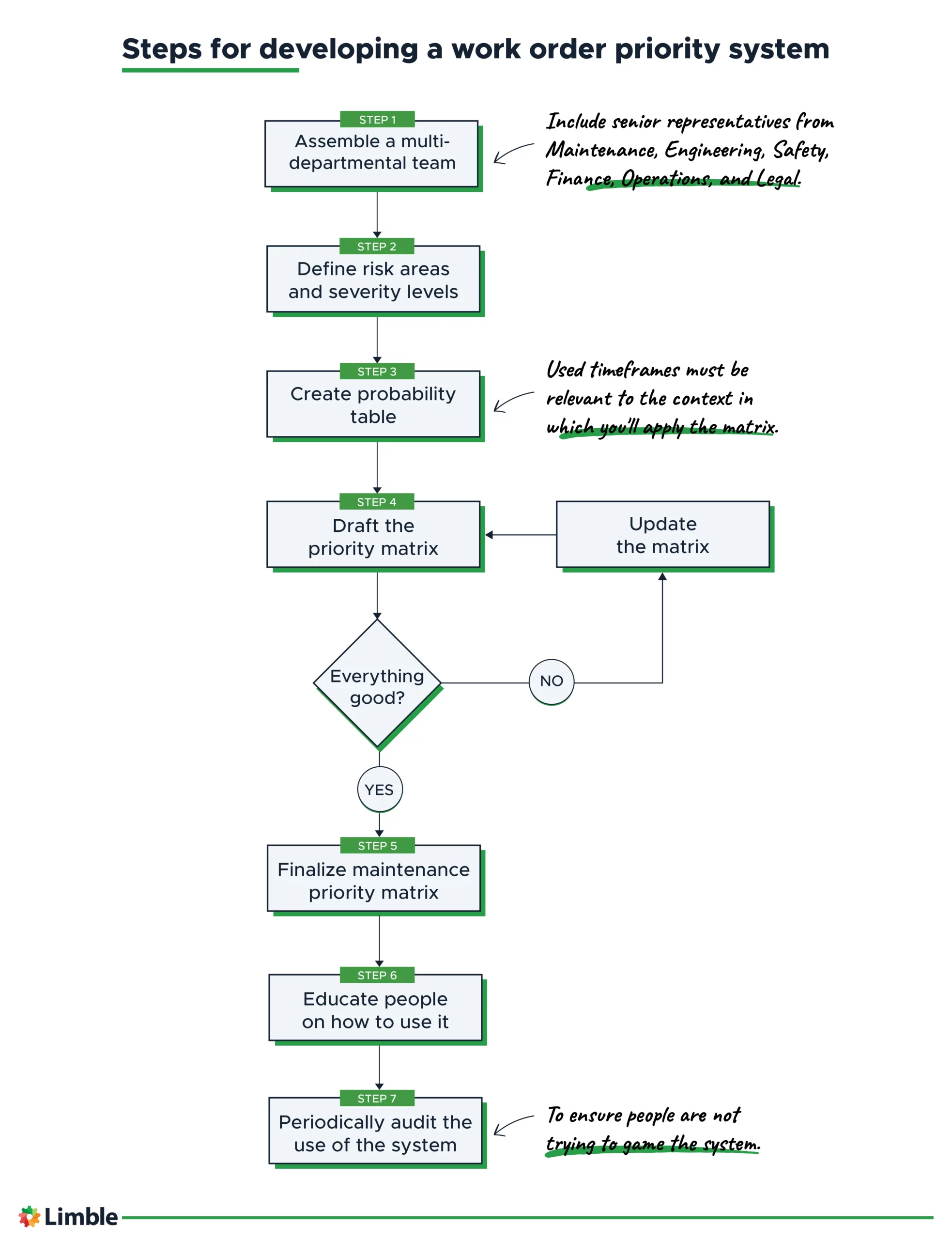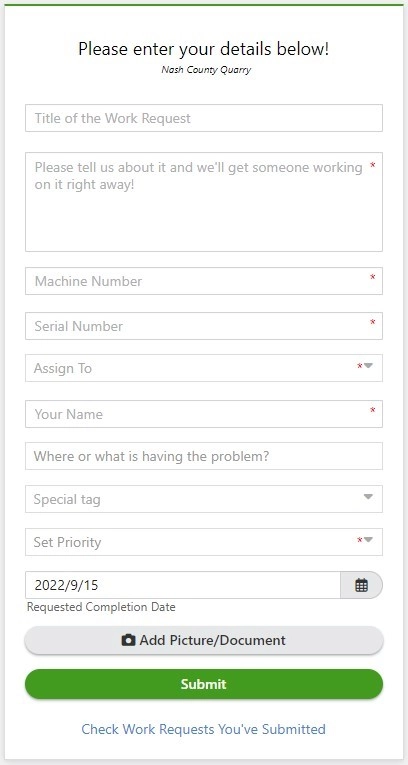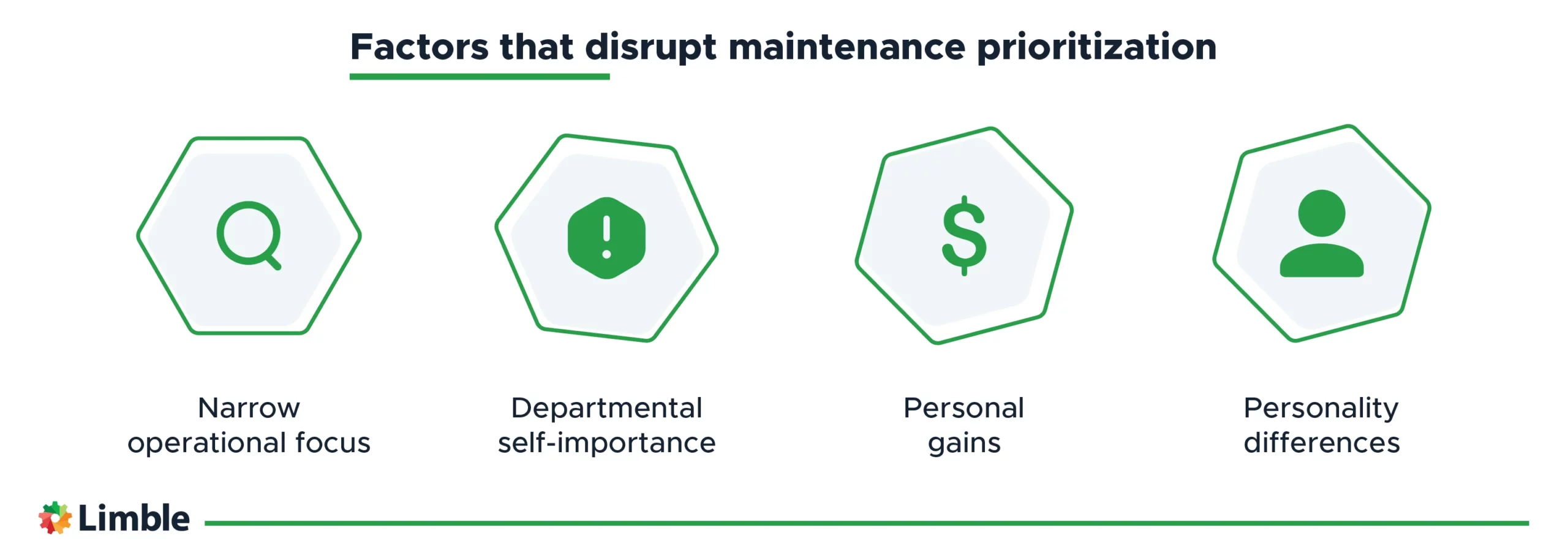Poor work order prioritization can cause delays and other operational issues.
Implementing a simple yet rigorous work order priority system is a quick way to improve both plant reliability and maintenance efficiency.
In this article, we’ll show you:
- How to create a work order priority system based on a maintenance priority matrix
- How to prioritize maintenance work
- How to use the matrix to reduce your costs and enhance the efficiency of your maintenance team
How to effectively prioritize maintenance work orders
Removing or reducing emotion and subjectivity in prioritizing maintenance work demands the use of measurable factors in all decision-making.
When determining priority, organizations commonly require their employees to consider the following:
- What is the risk to the business if maintenance of an issue does not occur?
- How severe are the consequences of the failure?
- What is the likelihood of those consequences coming true?
Two common decision-making tools or methodologies in work order prioritization are the:
- Analytical hierarchy process: Better suited for complex decision-making using psychology and mathematics. It is less useful as a quick and convenient tool for employee self-use.
- Risk-based matrix: An easy-to-use table that gives your workers a semi-quantitative, risk-weighted guide to choosing the right priority based on a series of predetermined risks.
Creating and applying the maintenance priority matrix
The following is a practical example of a maintenance risk matrix in action. Conceptually, it is almost identical to the tables used in asset criticality analysis.
The core of a risk matrix is in developing the risk areas and then quantifying the levels of severity for each risk. Both will be unique to your business.
Here are a few tips to help your understanding before we start (look at the table below as you are going through these bullet points):
- The matrix identifies the risk areas that the business feels are a priority.
- There are five levels of severity applied to each risk area, highlighting what that severity rating means for each area.
- The four right-hand columns of the table measure the probability of the risk occurring, with each colored box multiplying the severity number by the probability number to form a total risk number.
- Beneath the risk matrix is a table that helps apply the probability rating. The table gives guidance on what the business considers each probability means in calendar terms.
- Preventive maintenance tasks and regularly scheduled work generally fall outside of scope of the maintenance priority matrix, but should be considered equally important maintenance activities.
In this particular example, the business has decided that the chance of incurring costs between $5,000 and $50,000 forms a moderate financial risk. The rest of the “Financial” column is filled out using that as the baseline.
Example #1: Carton sealer defect
Imagine a production where the carton sealer on line three is beginning to malfunction. What risk number should we apply? Let’s see:
- We have four production lines, so the impact affects only 25% of the goods.
- We can continue operating all four lines; however, we must divert all cartons on line three to pallets and run them through one of the other three carton sealers without disrupting production flow.
- We can put in place controls to prevent manual handling incidents.
While the workaround is inconvenient, it has manageable safety risks. It does not increase operating costs, and the client is likely to receive their order on time.
In this example, the operator would decide the risk is operational and select “Isolated disruption, with redundancies,” which is severity level 2.
They assess that a complete failure will likely occur without maintenance in the next two months, so the probability is 3. The matrix returns a risk number of 6.
It’s an amber risk, indicating it’s an inconvenient fault. In other words, prolonged operation with an unserviceable sealer is not ideal, but it’s not business-critical.
Example #2: Deadman’s switch malfunction
In this example, let’s assume the business uses a single, manually-loaded 200-ton hydraulic press, and the pre-start checks by the operator prove that the deadman switch is not functioning.
This switch prevents press operation when released by the operator, stopping operation while hands or heads are in the vicinity of the tooling. Its serviceability is a regulatory requirement.
In this case, the risk matrix is clear. The fault presents a clear regulatory breach if the operator uses the press, so it is a 3 for legal severity, and if the operator used the press, a certain probability of 4, giving a risk rating of 12.
If we tag the press out, as it’s the only one, it will stop production until fixed. Rectification should take an hour, giving an operational severity of 4 and a certainty of 4, so a risk rating of 16.
If the press continues to be used and someone gets hurt, the safety and legal impacts will be either major or catastrophic, depending on the extent of injury to the operator. Whatever way you look at this fault, it has a high risk rating.
As continuing to operate the press is a criminal act, the operator will tag it out. The issue itself will have very high priority.
Pros and cons of the maintenance priority matrix
Every tool comes with advantages and disadvantages, and risk matrices have their critics.
Pros:
- Using a standard tool to guide and justify prioritization decisions dampens some of the subjectivity in the process.
- It forces users to consider tactical and strategic issues they might normally disregard.
- Places accountability onto the user, with their decisions auditable after the fact.
Cons:
- Doesn’t differentiate between volatile risks that may suddenly change and static risks that won’t.
- While attempting to add greater objectivity, a degree of subjectivity is still involved.
- Some argue that multiplying the indices to get a risk score provides an uneven distribution, with results that lack specificity and differentiation between faults.
While it is not perfect, a risk matrix is vastly superior to having no maintenance prioritization system in place.
Steps for developing your own work order priority system
To do this exercise thoroughly, we recommend running a workshop with representation from all affected departments.
Step 1: Develop risk areas and severity
Round up important stakeholders and senior representatives from the following departments to assess the highest priorities:
- Safety
- Finance
- Operations
- Legal
- Maintenance and Engineering
There will be lots of discussion and disagreement, but as these areas are quite empirical, you’ll rapidly form a table specific to your organization.
Step 2: Create the probability table
The probability table should clearly describe each probability level. As it is more subjective, it is bound to cause some friction.
Remember that it must be relevant to the context in which you’ll apply the matrix.
Some matrices use time frames like:
- 10 years for unlikely
- 5 years for possible
- 1 year for likely
- Imminent or already occurred for certain
However, is this relevant for a production line where better timeframes might be hours, days, or weeks?
These are decisions for you and your team to make during the development workshop.
Step 3: Issue and educate
With the final draft complete, circulate it for final discussion and sign-off before implementation. The education process begins after approval, with all employees required to use the matrix when raising and approving work orders.
When using a computerized maintenance management system (CMMS), you can make the priority field mandatory on the work request form, showing a copy of the risk matrix.
An example of Limble’s custom work request portal with the mandatory “Set Priority” field.
Step 4: Periodically audit the use of the system
Finally, be sure to emphasize that you will regularly audit the use of the prioritization system to ensure people aren’t trying to game the system by claiming heightened risk or probabilities.
You will only need to censure one or two individuals for inappropriate use before the system is used responsibly.
The effects of poor maintenance prioritization
Poor maintenance prioritization has a sea of negative effects. Here are the most common ones:
- Inefficient workflows: Without a prioritization system, maintenance becomes reactive. Often, important work gets delayed, and work that can wait gets done first. Eventually, this can create a backlog of crucial work that should have been done sooner.
- Poor equipment reliability: Equipment reliability depends on timely and targeted maintenance.Operating with a known fault can reduce asset maintainability, shorten asset lifespan, and increase breakdowns.
- Inflated maintenance costs: Expect your maintenance budget to be higher than necessary if the equipment is not receiving maintenance in a timely manner. Reactive maintenance and emergency maintenance will become your weekly reality. There are also hidden costs due to assets having shorter lives and more downtime.
- Maintenance technician frustration: Maintenance technicians take pride in their work. Being pulled back and forth between competing departments and carrying out work that is low priority, they know of higher-priority tasks is frustrating. If this state of affairs continues, it is bound to increase staff turnover.
- Safety issues: When equipment is not functioning properly, all kinds of safety problems can occur. Safety issues might include spontaneous machine movement or ineffective guarding systems, impacts introduced from workarounds or new methods, like manual handling or the introduction of forklifts to a workplace.
Workload prioritization is crucial in maintenance departments for ensuring the equipment that needs the most urgent attention gets worked on before those assets that pose less business risk.
Emotional factors that obstruct maintenance prioritization
Asking your team to prioritize maintenance work orders without imposing a formal prioritization system guarantees that objectivity will suffer.
To combat them, you first need to understand the emotional drivers that can skew your maintenance prioritization efforts.
Narrow operational focus
Sometimes production teams don’t see the whole picture when it comes to prioritizing maintenance tasks.
It may seem like continuing production at all costs is the right move, but there are often other factors to consider, like:
- Spares holdings
- Resource availability
- Maintenance costs
- Asset life
- Safety, environmental and legislative compliance
Each of these areas can increase costs, cause quality concerns, impose equipment damage, increase capital spending, incur fines, and even cause business suspension.
Without considering these areas in the context of maintenance, the wrong types of work can get prioritized, and results suffer.
Departmental self-importance
It feels like there is usually that one department in an organization that receives the most credit for business success — or takes priority when maintenance issues occur.
Often, it also seems that this department’s needs are prioritized above all else.
Unfortunately, meeting these demands takes away from the resources needed to support the rest of the organization. Other departments then struggle to perform to expectations, often failing to support their peers.
This leads to business inefficiency and interdepartmental resentment, weakening the company’s culture.
Personal gains
Businesses often reward their employees for achieving key performance indicators (KPI) by paying them annual bonuses. While such bonus schemes do drive a focus on important business issues, they can be counterproductive.
Imagine operators that are trying to reach a specific monthly production output.
When equipment requires maintenance intervention, the potential of personal financial loss overcomes wider business issues, with employees either overstating work urgency or delaying reporting the issue.
Personality differences
We all have different personalities. Some people are more extroverted, others are more reserved.
Without an auditable semi-quantitative system to balance maintenance work priority, some will naturally see their issues as highly important, while others will be more balanced in their assessment.
Such imbalance can cause friction among team members, damaging the organization’s attempts to create a common culture within the team.
Simplify maintenance prioritization with CMMS software
Implementing a consistent work order priority system for your business, followed by employee training and ongoing monitoring, is an effective way to minimize subjectivity when raising and approving work requests or scheduling work orders.
It results in a considerable improvement in work order prioritization and significantly improves your equipment reliability, operating costs, and maintenance efficiency.
Simplify your maintenance prioritization today by implementing Limble CMMS and getting a deep insight into your maintenance operations.



